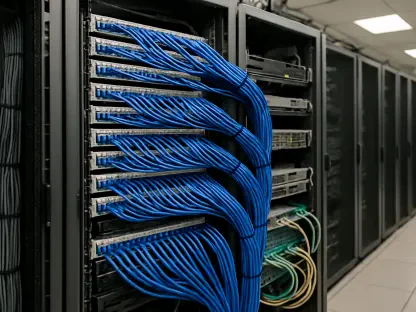In an era where scientific challenges demand unprecedented computational might, a Silicon Valley tech giant is stepping up to redefine the boundaries of discovery through cutting-edge supercomputing. With the deployment of over 80 advanced systems worldwide in just the past year, boasting a staggering combined AI performance of 4,500 exaFLOPs, this technological leader is fueling breakthroughs across diverse fields like disease simulation, climate forecasting, and quantum computing. Highlighted at the recent Supercomputing 25 conference in St. Louis, these efforts underscore a transformative shift in high-performance computing (HPC). Researchers and institutions globally are now equipped with tools to tackle complex problems at speeds previously unimaginable, paving the way for innovations that could reshape humanity’s understanding of the universe. This remarkable stride in computational power sets the stage for exploring how such advancements are driving scientific progress on a global scale.
Revolutionizing Research with Advanced Hardware
The backbone of these scientific leaps lies in state-of-the-art hardware, including Blackwell GPUs and Grace Hopper Superchips, paired with high-speed interconnects like Quantum-X800 InfiniBand networking. These technologies are meticulously engineered to handle intricate scientific tasks, from molecular dynamics that aid in disease research to astrophysical simulations unraveling cosmic mysteries. By delivering unparalleled computational speeds, such systems empower researchers to process vast datasets and model scenarios with precision that was once out of reach. Beyond raw power, the integration of AI-driven capabilities ensures that simulations and predictions are not only faster but also more accurate, opening new frontiers in materials science and seismic mapping. This fusion of hardware and intelligent computing is setting a new standard for what research institutions can achieve, enabling them to push beyond traditional limits and explore solutions to some of the world’s most pressing challenges with remarkable efficiency.
Equally significant is the adaptability of these systems to a wide array of scientific domains, ensuring that diverse fields benefit from the same technological advancements. Whether it’s forecasting climate patterns to mitigate environmental crises or simulating quantum algorithms for next-generation computing, the hardware’s versatility stands out as a key driver of innovation. Institutions equipped with these tools can tailor their computational approaches to specific needs, whether that involves crunching numbers for disaster preparedness or delving into the intricacies of human health at a molecular level. This customization, supported by robust networking solutions, fosters collaboration among global research teams, allowing data and insights to flow seamlessly across borders. As a result, the scientific community is witnessing a paradigm shift where technology not only accelerates discovery but also bridges gaps between disciplines, creating a more interconnected and dynamic research landscape that promises to yield transformative outcomes.
Groundbreaking Projects in the United States
Across the United States, several ambitious projects highlight the profound impact of supercomputing on scientific endeavors. At the Texas Advanced Computing Center (TACC), the forthcoming Horizon supercomputer is poised to deliver 80 exaFLOPs of AI compute power through 4,000 Blackwell GPUs. This system targets critical simulations in health, astronomy, and disaster readiness, providing researchers with the means to address multifaceted challenges with unprecedented depth. Meanwhile, in Illinois, Argonne National Laboratory (ANL) is preparing to unveil Solstice, a colossal system equipped with 100,000 Blackwell GPUs, capable of 1,000 exaFLOPs for AI training. This capacity nearly doubles the combined power of the entire TOP500 list, marking a historic milestone in computational ability. Such projects exemplify how advanced systems are equipping American institutions to lead in solving complex problems that span from public health crises to cosmic exploration.
Further demonstrating this momentum, ANL is also set to introduce Equinox alongside three additional systems focused on AI inference and workforce training, enhancing both research and educational capabilities. In New Mexico, Los Alamos National Laboratory (LANL) is rolling out the Mission and Vision systems, developed in collaboration with industry partners, to support classified nuclear security applications and open science research. These initiatives reflect a strategic focus on leveraging supercomputing for national priorities while fostering open collaboration in scientific inquiry. The diversity of applications—from securing critical infrastructure to advancing fundamental knowledge—illustrates the expansive role that high-performance computing plays in addressing both immediate and long-term challenges. By investing in such powerful systems, these laboratories are not only pushing the boundaries of what is computationally possible but also ensuring that the benefits of these advancements are felt across various sectors of society.
Global Impact and International Collaborations
On the international stage, the influence of supercomputing is equally transformative, with several notable systems making waves across continents. In Germany, the Jülich Supercomputing Centre’s JUPITER system, inaugurated recently, stands as Europe’s first exaFLOP system, powered by 24,000 G##00 Grace Hopper Superchips. Its performance is expected to secure a top position in the global TOP500 rankings, highlighting Europe’s growing prowess in HPC. Similarly, in Japan, RIKEN is developing two new supercomputers with Blackwell GPUs—one with 1,600 units for AI-driven scientific research and another with 540 units dedicated to quantum computing advancements. These projects underscore a global trend of harnessing computational power to drive innovation in specialized fields, ensuring that regions beyond the United States are also at the forefront of scientific progress through cutting-edge technology.
Adding to this international scope, a collaboration with Fujitsu on FugakuNEXT, the successor to the renowned Fugaku supercomputer, aims to achieve 100 times greater application performance by 2030 while integrating quantum technology. This partnership reflects a forward-thinking approach to combining traditional HPC with emerging paradigms, setting the stage for revolutionary discoveries in the coming years. The global distribution of these advanced systems fosters a collaborative environment where research institutions share knowledge and resources, amplifying the impact of each project. From simulating galactic formations to pioneering new medical treatments, the international reach of supercomputing ensures that solutions to global challenges are developed through a collective effort. This interconnected network of innovation highlights the universal importance of computational advancements in addressing humanity’s most critical questions and building a foundation for future breakthroughs.
Shaping the Future of Scientific Discovery
Reflecting on the strides made, the deployment of over 80 science-focused supercomputing systems worldwide, with a combined AI performance of 4,500 exaFLOPs, marks a historic turning point in research capabilities. Through strategic partnerships and pioneering hardware, transformative projects have emerged across diverse domains, from health to quantum computing, leaving an indelible impact on global science. Looking ahead, the focus should shift toward scaling these technologies to make them accessible to smaller institutions, ensuring broader participation in cutting-edge research. Additionally, continued investment in hybrid computing models that integrate AI and traditional HPC could further accelerate discovery, while international collaborations should be strengthened to tackle shared challenges. By prioritizing innovation and inclusivity, the scientific community can build on past achievements to unlock even greater potential, paving the way for solutions that address the world’s most urgent needs with precision and foresight.









